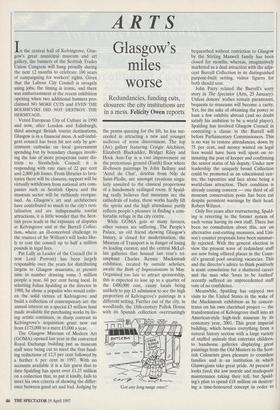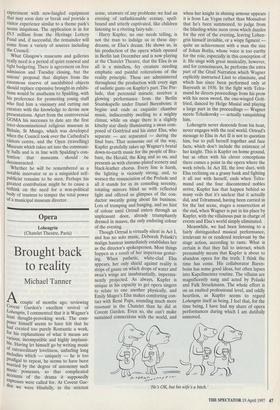ARTS
Glasgow's miles worse
Redundancies, funding cuts, closures: the city institutions are in a mess. Felicity Owen reports In the central hall of Kelvingrove, Glas- gow's great municipal museum and art gallery, the banners of the Scottish Trades Union Congress will hang proudly during the next 12 months to celebrate 100 years of campaigning for workers' rights. Given that the Labour City Council is savagely axing jobs, the timing is ironic, and there was embarrassment at the recent exhibition opening when two additional banners pro- claimed NO MORE CUTS and EVEN THE BOLSHEVIKS DID NOT DESTROY THE HERMITAGE.
Voted European City of Culture in 1990 and now, after London and Edinburgh, third amongst British tourist destinations, Glasgow is in a financial mess. A self-indul- gent council has been hit not only by gov- ernment cutbacks on local government spending but by boundary changes involv- ing the loss of more prosperous outer dis- tricts to Strathclyde Council: it is responding with rate rises of 22 per cent and 2,000 job losses. From libraries to lava- tories there will be closures, support will be virtually withdrawn from national arts com- panies such as Scottish Opera and the museum sector will be ruthlessly reorgan- ised. As Glasgow's art and architecture have contributed so much to the city's revi- talisation and are indispensable tourist attractions, it is little wonder that the Scot- tish press leads in the exposure of disputes at Kelvingrove and at the Burrell Collec- tion, where an ill-conceived challenge to the trustees of Sir William's will looks like- ly to cost the council up to half a million pounds in legal fees.
Pat Lally as Leader of the Council (he is now Lord Provost) has been largely responsible over the years for distributing largess to Glasgow museums, at present nine in number drawing some 3 million people a year, 60 per cent being local. In selecting Julian Spalding as the director in 1988, he chose a populist who would enliv- en the solid virtues of Kelvingrove and build a collection of contemporary art: the annual interest on a special £3 million fund made available for purchasing works by liv- ing artists continues, in sharp contrast to Kelvingrove's acquisition grant now cut from £175,000 to a mere £5,000 a year.
The Glasgow Museum of Modern Art (GOMA) opened last year in the converted Royal Exchange building just as museum staff were being cut to meet the first fund- ing reductions of 12.5 per cent followed by a further 6 per cent in 1997. With no accounts available it is a fair guess that to date Spalding has spent over £1.25 million on a collection that, to put it kindly, fails to meet his own criteria of showing the differ- ence between good art and bad. Judging by the prams queuing for the lift, he has suc- ceeded in attracting a new and younger audience of some discernment. The top (Air) gallery featuring Craigie Aitchison, Elizabeth Blackadder, Bridget Riley and Hock Aun-Tay is a vast improvement on the pretentious ground (Earth) floor where ill-chosen paintings by John Bellany and Autel du Chat', detritus from Niki de Saint-Phalle, are amongst creations singu- larly unsuited to the classical proportions of a handsomely ceilinged room. If Spald- ing really believes that museums are the cathedrals of today, these works hardly lift the spirits and the high attendance partly reflects people's pleasure in finding a com- fortable refuge in the city centre.
While GOMA gets so many favours, other venues are suffering. The People's Palace, an old friend showing Glasgow's history, is closed for modernisation, the Museum of Transport is in danger of losing its leading curator, and the central McLel- lan galleries that housed last year's tri- umphant Charles Rennie Mackintosh exhibition, created by outside scholars, awaits the Birth of Impressionism in May. Organised too late to attract sponsorship, this is expected to lose up to a quarter of the £400,000 cost, canny locals being unlikely to pay £5 admission to see the high proportion of Kelvingrove's paintings in a different setting. Further out of the city, in woodlands, the 18th-century Pollok House with its Spanish collection overtrustingly `Got any long range ones?' bequeathed without restriction to Glasgow by the Stirling Maxwell family has been closed for months, whereas, imaginatively marketed as a dual attraction with the adja- cent Burrell Collection in its distinguished purpose-built setting, visitor figures for both should soar.
John Parry related the Burrell's sorry story in The Spectator (Arts, 25 January). Unless donors' wishes remain paramount, bequests to museums will become a rarity. Yet, for the sake of obtaining the power to loan a few exhibits abroad (and no doubt satisfy his ambition to be a world player), Spalding has involved Glasgow Council in contesting a clause in the Burrell will before Parliamentary Commissioners. This is no way to restore attendances, down by 75 per cent, and money wasted on legal fees would have been well spent on re- instating the post of keeper and confirming the senior status of his deputy. Under new leadership the uniquely broad Collection could be promoted as an educational cen- tre, the tapestries and lace alone being a world-class attraction. Their condition is already causing concern — one third of all museum conservation posts has been cut despite persistent warnings by their head, Robert Wilmot.
Only five years after restructuring, Spald- ing is reverting to the former system of each venue having its own staff. There has been no consultation about this, nor on alternative cost-cutting measures, and Uni- son's counter proposals have been summar- ily rejected. With the general election in view the present wave of redundant staff are now being offered places in the Coun- cil's general pool awaiting vacancies. This and the director's advice to think positively is scant consolation for a shattered career and the man who 'loves to be loathed' recently suffered an unprecedented staff vote of no confidence.
Meanwhile, Spalding has enjoyed two visits to the United States in the wake of the Mackintosh exhibition as he concen- trates on his own cherished project — the transformation of Kelvingrove itself into an American-style high-tech museum by its centenary year, 2001. This great imperial building, which houses everything from a natural history section with a large variety of stuffed animals that entertain children, to handsome galleries displaying great paintings from the Old Masters to the Scot- tish Colourists gives pleasure to countless families and is an institution in which Glaswegians take great pride. At present it looks tired, the low morale and inadequate maintenance taking their toll, but Spald- ing's plan to spend £18 million on destroy- ing a time-honoured concept in order to experiment with new-fangled equipment that may soon date or break and provide a visitor experience similar to a theme park's seems iniquitous. The application is in for £9.5 million from the Heritage Lottery Fund and, if successful, the remainder will come from a variety of sources including the Council.
What Glasgow's museums and galleries really need is a period of quiet renewal and tight budgeting. There is agreement on free admission and Tuesday closing, but the unions' proposal that displays from the enormous reserve of unexhibited objects should replace expensive brought-in exhibi- tions would be anathema to Spalding, with his preference for promoting young staff who find him a visionary and cutting out curators with the knowledge to devise new presentations. Apart from the controversial GOMA his successes to date are the first inter-denominational religious museum in Britain, St Mungo, which was developed when the Council took over the Cathedral's visitors centre, and the Open (travelling) Museum which takes art into the communi- ty halls and is in line with Spalding's con- tention that museums should be deconstructed.
Whether he will be remembered as a notable innovator or as a misguided self- publicist remains to be seen. Perhaps his greatest contribution might be to cause a rethink on the need for a non-political body of trustees to temper the total power of a municipal museum director.



































































 Previous page
Previous page